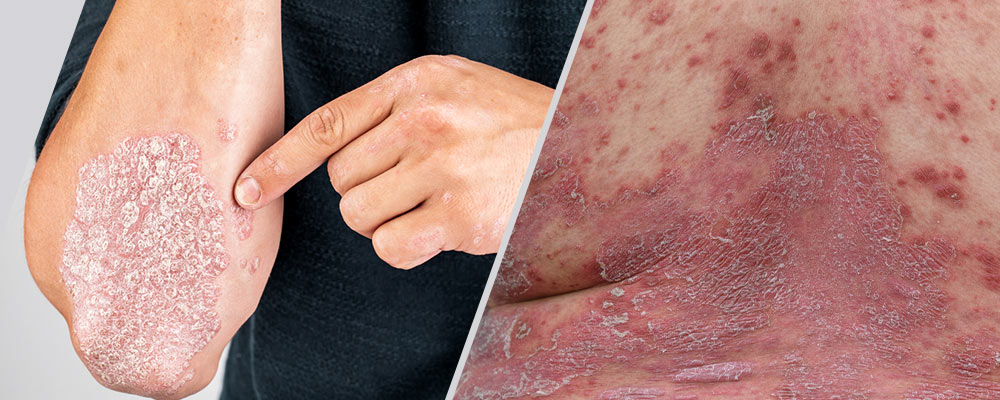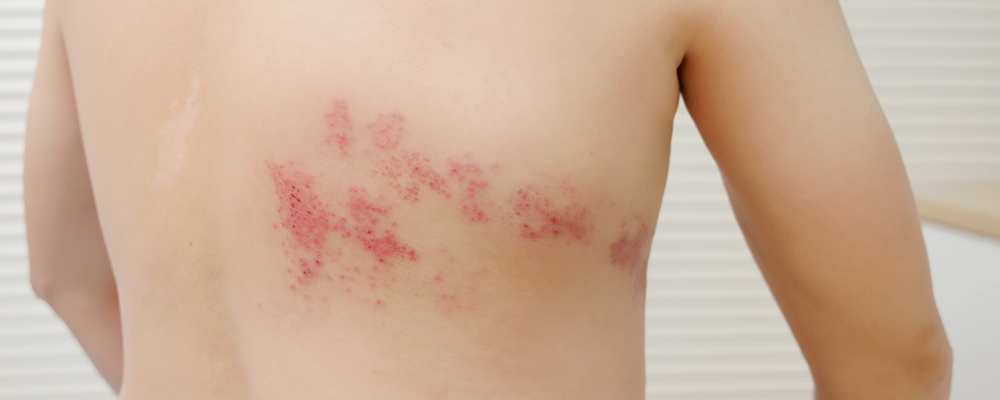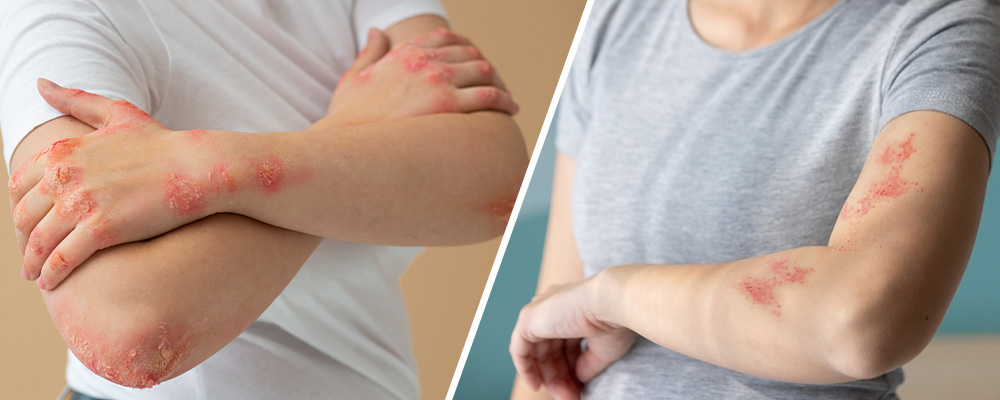Last Updated on January 23, 2024
There are two skin conditions: psoriasis and shingles. They can both cause painful, itchy rashes over substantial portions of skin. However, they diverge greatly regarding diagnosis, treatment, and transmission.
 Introduction
Introduction
When differentiating Psoriasis vs Shingles, it is crucial to recognize the specific signs and symptoms associated with each. When a new rash or itchy spot appears on your body, you may be concerned about whether it’s caused by psoriasis or another skin ailment like shingles, eczema, poison ivy, or lesions. Individuals with psoriasis may be especially vulnerable to developing shingles, as research suggests a possible link between the two conditions. Knowing little about these two skin disorders will help you recognize possible signs and anticipate treatment outcomes.
One MyPsoriasisTeam member said, “If you have psoriasis and one of your flare-ups looks different than typical, you should see a doctor to rule out shingles or another serious rash or allergy.”
This article compares psoriasis and shingles, two prevalent skin conditions with different causes and treatments but some similar symptoms.
Psoriasis vs Shingles: What is it?
Psoriasis is an autoimmune skin disease that is chronic (long-lasting), resulting in a fast build-up of skin cells on the surface. Though symptoms of psoriasis can appear anywhere on the body, they most frequently affect the scalp, knees, and elbows. Raised, scaly patches or plaques that may flake, itch, burn, or sting are among the most typical symptoms. Treatments for psoriasis can help you control your symptoms and enhance your quality of life, but it is not incurable.

The most common psoriasis, plaque psoriasis, usually appears as elevated skin areas that blister and become inflammatory.
According to the Cleveland Clinic, plaque psoriasis is the most prevalent, making up 80–90% of cases.
Enzymatic psoriasis
About 30% of persons with psoriasis will develop psoriatic arthritis, according to the National Psoriasis Foundation. However, it is impossible to transmit psoriasis to other people.
Introduction
The same virus that causes chickenpox also causes shingles, often known as herpes zoster (varicella). The name of this virus is varicella-zoster. Chickenpox is the initial symptom of the virus when it first appears. Even when you recover, the virus remains in your body and can reactivate as shingles at a later age. One side of the body, usually the torso, experiences a painful, blistering rash as the most typical cutaneous symptom of shingles.
According to the Centers for Disease Control and Prevention (CDC), almost one out of every three Americans will get shingles. As one age, their chance of getting shingles rises.
While shingles is not contagious in and of itself, the virus is. If you get shingles blisters and infect someone else with the varicella-zoster virus, that person may acquire chickenpox if they haven’t already had the disease or had the vaccination. They might get shingles if the virus reactivates later. The virus cannot be spread once the blisters have healed and scabbed over.

The same virus that causes chickenpox also causes shingles. A severe, blistering rash on one side of the body, usually the chest, is the most typical skin symptom. (Stock from Adobe)
Symptoms Differences in Psoriasis vs Shingles
Nature of Lesions:
Psoriasis presents with scaly, well-defined plaques, while shingles manifest as a painful rash with fluid-filled blisters following a nerve’s path.
Pain:
Pain is a prominent feature in shingles, often preceding the appearance of the rash. However, psoriasis is typically not associated with severe pain.
Distribution:
Psoriasis lesions can appear anywhere on the body, while shingles follow a specific nerve pathway.
Systemic Symptoms:
Shingles commonly present with systemic symptoms like fever and headache, which are uncommon in psoriasis.
Risk Factors of Psoriasis vs Shingles
Navigating the complexities of Psoriasis vs Shingles requires a comprehensive understanding of their unique symptoms, risk factors, and preventive measures. Although the exact etiology of psoriasis is still unknown, some reasons and triggers that may cause flare-ups have been found.
Among the causes and triggers of psoriasis are:
- Family background
- Stress
- skin injuries such as sunburns, cuts, and scrapes
- Some diseases, such as tonsillitis or bronchitis
- Certain infections, such as strep throat or a skin infection
- chilly, dry weather conditions
- excessive alcohol drinking
- Consuming tobacco
Psoriasis can affect anyone, although it is more likely to affect you if one or both of your parents have it.
The varicella-zoster virus, commonly known as human herpesvirus 3, causes shingles. However, shingles can infect anyone with chickenpox or receive the live vaccine. People under 40 are less likely to have it, but as people age, their risk increases. The majority of shingles patients experience symptoms in their 50s or later.
Risk factors for shingles include:
- Old age
- Having immune system weakness
- receiving chemotherapy or radiation therapy for cancer
- Long-term use of steroids, such as prednisone
- Taking drugs that inhibit the immune system
However, the Shigrix recombinant zoster vaccination decreases your chances of contracting shingles. The CDC advises the two-shot immunization in people 50 years of age and above. The sole method to prevent shingles and postherpetic neuralgia, a consequence of shingles that can cause excruciating pain in the skin and nerves even after the blisters and severe rash have healed, is to get the vaccination.
The FDA in the United States has cleared Shingrix for use by patients suffering from autoimmune and inflammatory diseases such as psoriasis. See your doctor for advice if you have any concerns about the shingles vaccine.
Psoriasis vs Shingles: Prevention
Preventing the onset or recurrence of shingles and psoriasis involves a combination of lifestyle modifications, vaccination, and proactive healthcare measures. While complete prevention may not always be possible, adopting these strategies can significantly reduce the risk and severity of both conditions.
Preventing Shingles:
Vaccination:
Vaccination is the most reliable means of shingles prevention. However, the shingles vaccine, typically a two-dose series, is recommended for individuals aged 50 and older.
Early Treatment of Chickenpox:
Ensuring prompt medical attention and treatment for chickenpox in children can reduce the risk of the varicella-zoster virus reactivating later in life to cause shingles.
Maintaining a Healthy Immune System:
Strengthening the immune system through a balanced diet, regular exercise, and adequate sleep can contribute to overall health and reduce the risk of shingles.
Stress Management:
Chronic stress is associated with immune system suppression, potentially triggering shingles reactivation. However, stress-management techniques prove to be beneficial in these cases.
Avoiding High-Risk Environments:
Limiting exposure to individuals with active chickenpox or shingles can reduce the risk of transmission. People who have compromised immune systems ought to be very cautious.
Preventing Psoriasis Flare-ups:
Identifying and Managing Triggers:
Understanding triggers for psoriasis flare-ups, such as stress, infections, or certain medications. However, once identified, efforts should be made to manage or avoid these triggers.
Skincare Practices:
Keeping the skin well-moisturized and avoiding harsh skincare products can help manage psoriasis symptoms. Furthermore, bathing in lukewarm water and using fragrance-free, hypoallergenic soaps is recommended.
Balanced Diet:
While no specific diet can cure psoriasis, maintaining a balanced and nutritious diet can support overall health. Additionally, some individuals find that reducing the intake of certain inflammatory foods may help manage symptoms.
Regular Medical Check-ups:
Regular follow-ups with healthcare providers allow for monitoring psoriasis and adjusting treatment plans.
Avoiding Smoking and Excessive Alcohol:
Both smoking and excessive alcohol consumption have been linked to an increased risk of psoriasis and may exacerbate symptoms. Additionally, quitting smoking and moderating alcohol intake can positively impact overall skin health.
General Skin Health Tips:
Sun Protection:
Protecting the skin from excessive sun exposure is crucial for individuals with psoriasis and can prevent skin damage.
Hydration:
Adequate hydration is essential for maintaining skin health.
Regular Exercise:
Engaging in regular physical activity not only supports overall well-being but can also contribute to a healthy immune system and improve skin health.
Proactive Medical Consultation:
Any unusual changes in the skin should prompt a visit to a healthcare provider. Early detection and intervention can prevent the progression of skin conditions.
How Are Shingles and Psoriasis Treated?
Since psoriasis is an autoimmune condition, your doctor may suggest immune system-boosting medications. However, they may recommend antiviral medicine for shingles.
Psoriasis treatments include:
- Vitamin D in synthetic form, such as calcitriol (Vectical) and calcipotriene (Dovonex)
- Topical steroids available over-the-counter, such as hydrocortisone gels, creams, and lotions
- prescription corticosteroid creams or ointments, such as clobetasol and triamcinolone radiation treatment, often known as phototherapy, which uses both artificial UV radiation and sunlight
- calcineurin inhibitors, including pimecrolimus (Elidel) and tacrolimus (Protopic)
- retinoid gels or creams, such as Tazorac (tazarotene)
- injections of steroids
- Methotrexate (Rasuvo, Trexall, Ostexup)
- The cyclosporine biologics ixekizumab (Taltz), secukinumab (Cosentyx), tildrakizumab-asmn (Ilumya), etanercept (Enbrel), guselkumab (Tremfya), apremilast (Otezla), certolizumab pegol (Cimzia), and ustekinumab (Stelara) are among the cyclosporine biologics.
To find a treatment that works for you, you and your healthcare practitioner might need to test a variety of medications or therapy combinations. Inquire about possible allergic reactions and adverse effects before beginning psoriasis therapy.
The American Academy of Dermatology states that shingles rashes resolve independently without medical intervention. Experts advise getting treatment right once to lessen your discomfort, reduce the time it takes, and lower your chance of complications.
Shingle treatments include:
- Antiviral drugs such as famciclovir (Famvir), valacyclovir (Valtrex), and acyclovir (Sitavig or Zovirax)
- Anticonvulsants such as gabapentinan
- Intravenous corticosteroids
- topical numbing agents, such as lidocaine spray or cream
- topical pain reliever, such as a capsaicin patch
- Tricyclic depression medications, such as amitriptyline
- Painkillers available over-the-counter
Conclusion:
In conclusion, differentiating psoriasis vs shingles is crucial for accurate diagnosis and effective management. While psoriasis is a chronic autoimmune condition characterized by the overproduction of skin cells, shingles is an infectious disease resulting from the reactivation of the varicella-zoster virus. Therefore, recognizing each condition’s unique signs, symptoms, and causes allows individuals to seek timely medical attention and adopt suitable treatment strategies. By shedding light on these two skin disorders, this blog aims to empower individuals with the knowledge needed to navigate the complexities of psoriasis and shingles.

 Introduction
Introduction